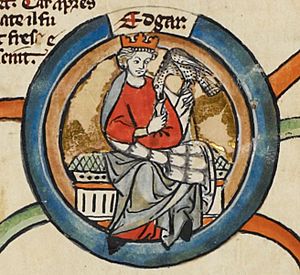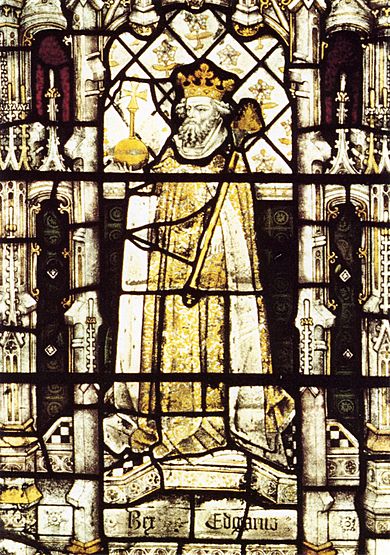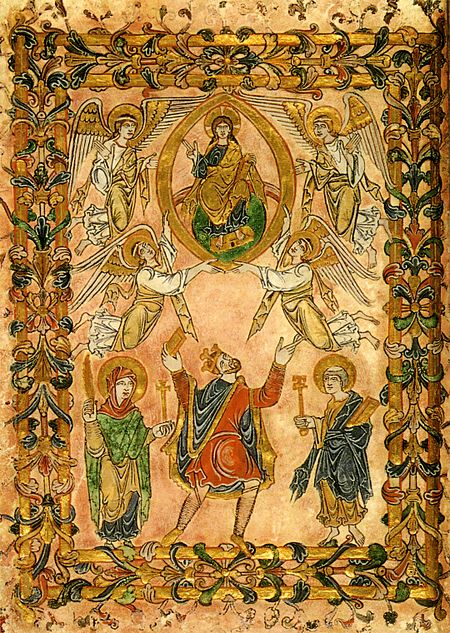Edgar, King of England facts for kids
Quick facts for kids Edgar |
|
|---|---|

Edgar in the early fourteenth-century Genealogical Roll of the Kings of England
|
|
| King of England | |
| Reign | 1 October 959 – 8 July 975 |
| Predecessor | Eadwig |
| Successor | Edward the Martyr |
| Born | 943/944 England |
| Died | 8 July 975 (aged 31/32) |
| Burial | Glastonbury Abbey |
| Spouse |
|
| Issue | |
| House | Wessex |
| Father | Edmund I |
| Mother | Ælfgifu of Shaftesbury |
Edgar (born 943 or 944, died 8 July 975) was a powerful King of England. He ruled from 959 until his death in 975. Edgar was the younger son of King Edmund I and his first wife, Ælfgifu.
During his reign, England enjoyed a time of peace and stability. There were no major Viking attacks, which was unusual for the time. Edgar is best known for strongly supporting the English Benedictine Reform. This was a big movement that changed religious life in England. It also led to a flourishing of art and literature.
Edgar made important changes to how the country was run. He introduced a new, standard system for coins across England. He also made sure that laws were followed properly. After his death, his sons fought over who would be king. Later, people looked back at Edgar's time as a "golden age" because it was so peaceful and well-managed.
Contents
How Edgar Became King
England Before Edgar
For over a hundred years, England faced many attacks from Vikings. In 865, a large Viking army invaded. By 878, they had taken over much of England. Only the kingdom of Wessex was left. Its king, Alfred the Great, won a big battle and saved Wessex.
Alfred's son, Edward the Elder, and his daughter, Æthelflæd, continued to fight the Vikings. They slowly took back more land. By 927, Alfred's grandson, Æthelstan, became the first king to rule all of England.
Edgar's Family and Early Life
Edgar's father, Edmund, became king after Æthelstan. But Edmund was killed in 946. Because Edgar and his older brother, Eadwig, were very young, their uncle Eadred became king. Eadred also ruled all of England.
Edgar was born in 943 or 944. His mother, Ælfgifu, died when he was a baby. He was raised by Ælfwynn, the wife of a powerful nobleman named Æthelstan Half-King. This family strongly supported a religious movement called the Benedictine reform.
Edgar also studied at Abingdon Abbey. His teacher there was Æthelwold, a key leader of the Benedictine reform. This upbringing deeply influenced Edgar's strong support for monks and monasteries later in his life.
Edgar and King Eadwig
When King Eadred died in 955, Edgar's older brother, Eadwig, became king. Eadwig was only about fifteen years old. Historians often say Eadwig was not a very good ruler. He gave away a lot of land and argued with important advisors.
One of these advisors was Dunstan, a very respected church leader. Eadwig sent Dunstan away from England. Edgar, however, stayed close to his brother's court and was seen as an important prince.
The Kingdom Divides
In 957, something big happened: the kingdom was divided. Eadwig continued to rule the southern part of England, south of the River Thames. Edgar became king of the northern part, including Mercia and Northumbria.
Historians are not completely sure why the kingdom was divided. Some think it was because Eadwig's rule was causing problems. Others believe it might have been a planned decision to share power between the brothers.
When Edgar became king of Mercia, he brought Dunstan back from exile. Dunstan soon became a powerful bishop in Edgar's part of the kingdom. This shows that Edgar was already making his own decisions.
King of All England
Edgar Takes the Throne
On 1 October 959, King Eadwig died. This meant Edgar became the king of all England. He was still quite young, but he quickly became a strong ruler.
Edgar kept many of the same powerful nobles and advisors who had served his brother. However, he also brought in new people, especially those who supported the Benedictine reform. His former teacher, Æthelwold, became a very important advisor. Dunstan also became Archbishop of Canterbury, the most important church leader in England.
How Edgar Ruled
Edgar's government was very organized. He did not have one fixed capital city. Instead, his court traveled around the country several times a year. This helped him stay in touch with different regions.
He also made sure that laws were followed. If a community committed a crime, Edgar would punish them. For example, he once ordered people on the Isle of Thanet to be punished because they robbed traders.
New Laws and Order
Edgar issued new laws to improve justice. He wanted to make sure that existing laws were properly enforced. His laws were created with the advice of his most important councillors.
One of his main goals was to make sure that everyone had access to fair justice. He also wanted to standardize things across the kingdom. For example, he ordered that "one coinage is to be current throughout all the king's dominion." This meant all coins would be the same.
In some parts of England, especially where Vikings had settled, people had different customs. Edgar allowed them to keep some of their own laws. But he also made sure that certain rules, like those about selling stolen goods, were the same everywhere.
Standardizing Money
Before Edgar, the silver penny was the main coin, but its quality and weight varied a lot. Different mints (places where coins are made) produced different designs.
Towards the end of his reign, Edgar made a huge change. He introduced a new, standardized coinage system. All coins across the country had the same design. They were also made of very pure silver, about 96% pure. This was very high quality for the time.
This reform showed how strong Edgar's control was over his kingdom. It helped to unite England and made trade easier. This new coinage system lasted for over 150 years, which was a big achievement.
Edgar's Family Life
Edgar had children with three different women.
- His first partner was Æthelflæd. Their son was Edward the Martyr, who later became king.
- His second partner was Wulfthryth. They had a daughter named Edith. Wulfthryth later became a nun, which allowed Edgar to marry again.
- His third wife was Ælfthryth. She was a very influential queen. They had two sons, Edmund (who died young) and Æthelred. Ælfthryth was the first West Saxon queen to be officially crowned and to sign charters as "queen." She played an important role in politics.

Supporting the Church

Edgar was a huge supporter of the Benedictine reform movement in the church. This movement wanted to bring back strict rules for monks and nuns. When Edgar became king, there were only two Benedictine monasteries in England. With his help, many more were founded or reformed.
He worked closely with key church leaders like Dunstan, Æthelwold, and Oswald. Æthelwold, for example, changed the New Minster in Winchester from a community of secular clergy (who could marry) into a monastery for monks. Edgar even sent soldiers to help remove the old clergy.
Edgar wanted all monasteries in England to follow the same rules. He ordered a document called the Regularis Concordia to be written. This document set out a single set of rules for all English monasteries. It also said that monks should pray for the king and queen every day.
Edgar was very generous to churches and monasteries. He gave them land, gold, and precious objects. This support helped the Benedictine reform to grow strong.
Learning and Art
Edgar's reign was a golden age for learning and art in England. Before his time, knowledge of Latin had declined. But Edgar's support for monasteries helped bring about a revival.
Scholars like Æthelwold and Dunstan were very learned. They translated important religious texts from Latin into English. Many beautiful books were created during this time, like the Benedictional of St. Æthelwold. These books were often decorated with gold and precious stones.
Artists and goldsmiths from other countries were invited to England. They created amazing paintings and sculptures. This period produced some of the finest art ever seen in England.
Coronation and Power
On 11 May 973, Edgar had a special coronation ceremony at Bath. He was crowned king and Ælfthryth was crowned queen. This was a very grand event, perhaps inspired by ceremonies in other European kingdoms.
After his coronation, Edgar traveled to Chester. There, several other kings from Britain met him. These included kings from Scotland, Wales, and the Isles. Some stories say that these kings rowed Edgar in a boat on the River Dee as a sign of their respect and submission to his power.
This event showed Edgar's claim to be the overlord of all Britain. He used titles like "ruler of Britannia" in his charters. While his actual control over other kingdoms might have been less than he claimed, these events showed his great power and influence.
Edgar's Death and Legacy
Edgar died on 8 July 975, when he was only 31 or 32 years old. He was buried at Glastonbury Abbey, a place important to the Benedictine reform he supported.
After his death, there was a fight over who would be the next king. His oldest son, Edward the Martyr, became king with the support of Dunstan. But Edward was murdered three years later. Then, Edgar's younger son, Æthelred, became king. Æthelred's reign was very difficult, with new Viking attacks.
Later writers often praised Edgar's reign as a time of great peace and order. They saw it as a "golden age" compared to the troubles that came after him. Some historians call him "Edgar the Peaceful" because of the stability he brought to England. He is remembered as a king who greatly strengthened the English kingdom and its church.
Images for kids
See also
 In Spanish: Edgar el Pacífico para niños
In Spanish: Edgar el Pacífico para niños




